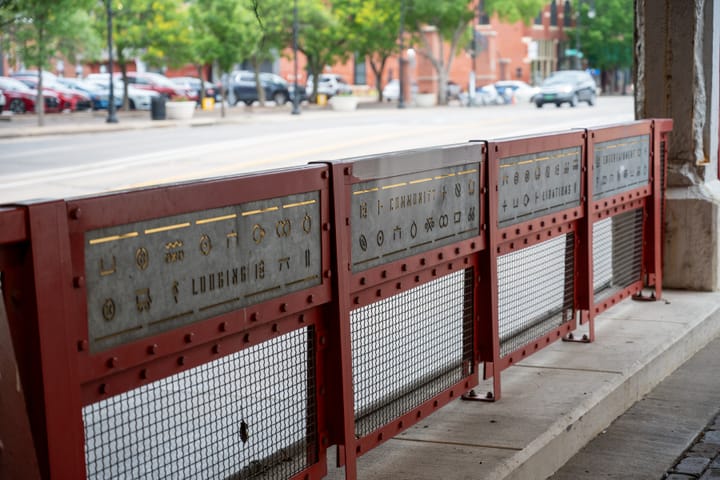Fountain has a ‘colt’ following: Victoria Park public art piece represents care for animal welfare & community aesthetics
This installment in an ongoing series about the City of Wichita's public art collection delves into the National Humane Alliance Fountain in Midtown.
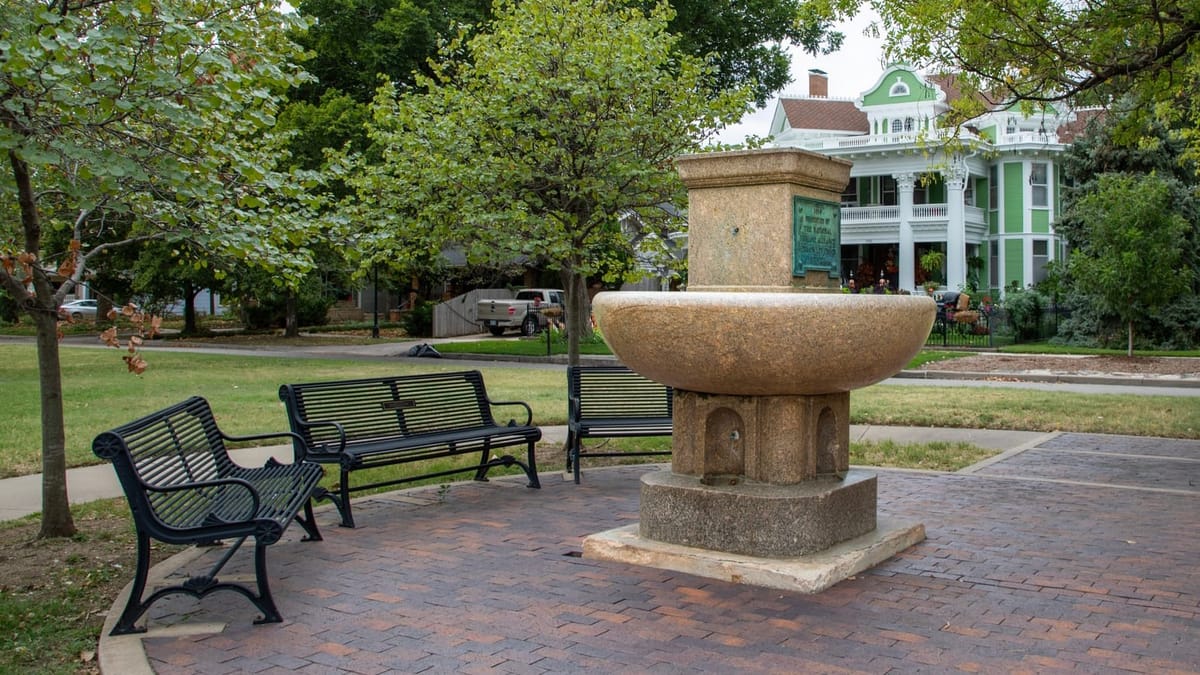
“If horses and dogs could read, they would get much pleasure out of this announcement!” the Wichita Beacon whinnied on August 23, 1910. “It’s all free.” Through the summer and fall, the Beacon followed the progress of a fountain — from learning it was available as a potential gift to the city through its delivery and installation. Though it no longer provides a service to Wichita’s canine or equine community, the National Humane Alliance Fountain is still part of the City of Wichita public art collection. It is the central feature of Victoria Park, a traffic island triangle at 17th Street and Park Place.
The fountain stands at the center of a brick terrace in the park with four benches on its south side. On a sunny fall afternoon, it is cool to the touch, with a surface that is smooth but not glassy. Its base is square with rounded corners. Above it is a block with a small alcove in the center of each side.
Resting on the block at the center of the structure is a wide, shallow bowl that collects water. Rising from the center of the basin is a square pillar topped with an angled slab. In the shade, the fountain mostly reads as gray, but in the sunlight its blacks stand out like spots on a roan horse, and the overall effect can be beige, peach, or pink.
A plaque on the north face of the upper block reads “1910. Presented by the National Humane Alliance. Herman Lee Ensign Founder.”
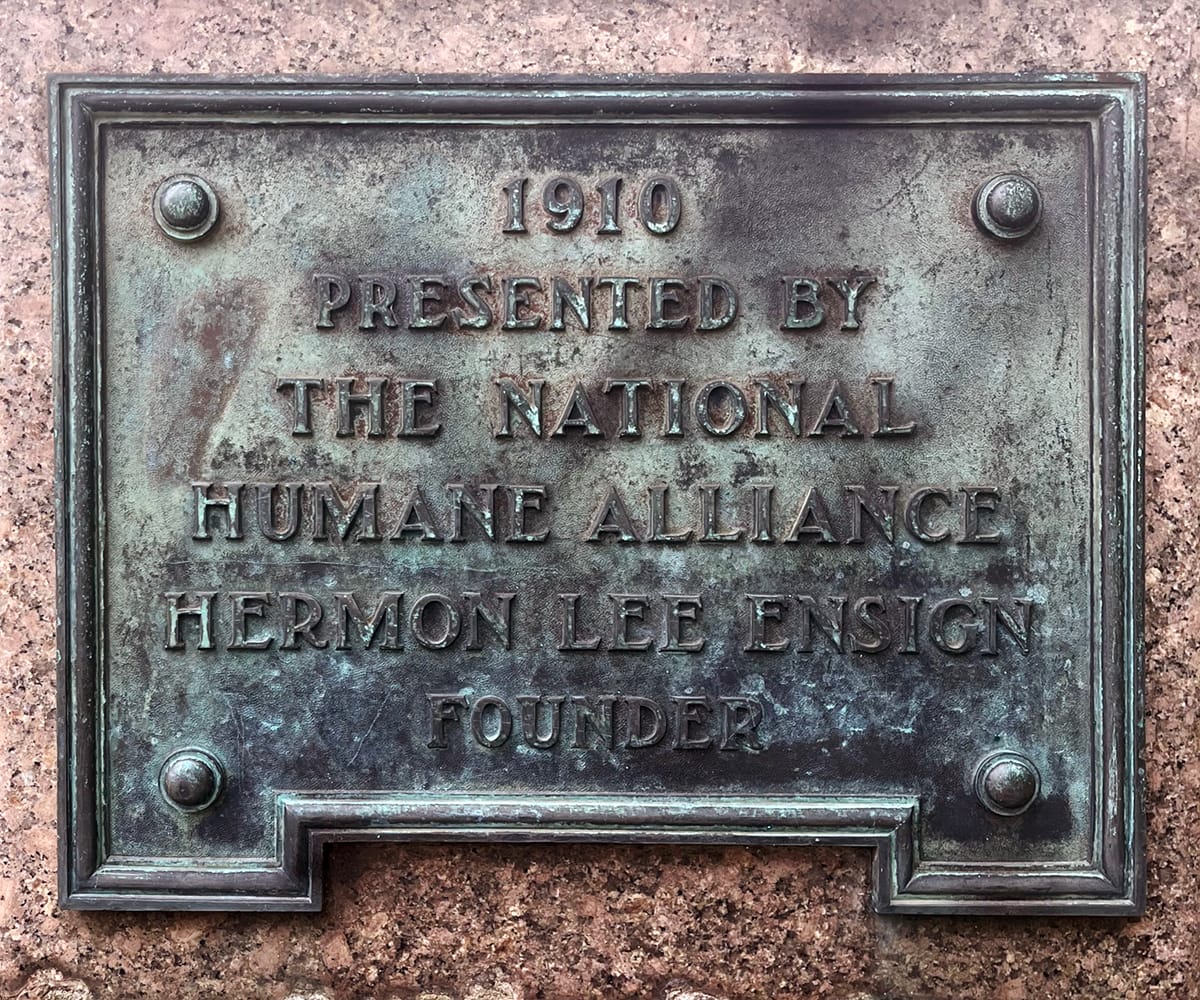
Sadly, the fountain is missing some of its original distinguishing features. When originally put in place, it featured a bronze lamp installed by W.H. Shuker, the city electrician. (As this was barely 30 years after Edison introduced the electric streetlight, I find it impressive that Wichita had a city electrician.)
It is not clear how many years the lamp lasted or even precisely what it looked like. A photo of another National Humane Alliance Fountain installed across from the state capitol in Carson City, Nevada, shows a glass-domed lamp extending from the top, increasing the piece’s overall height by about a third.
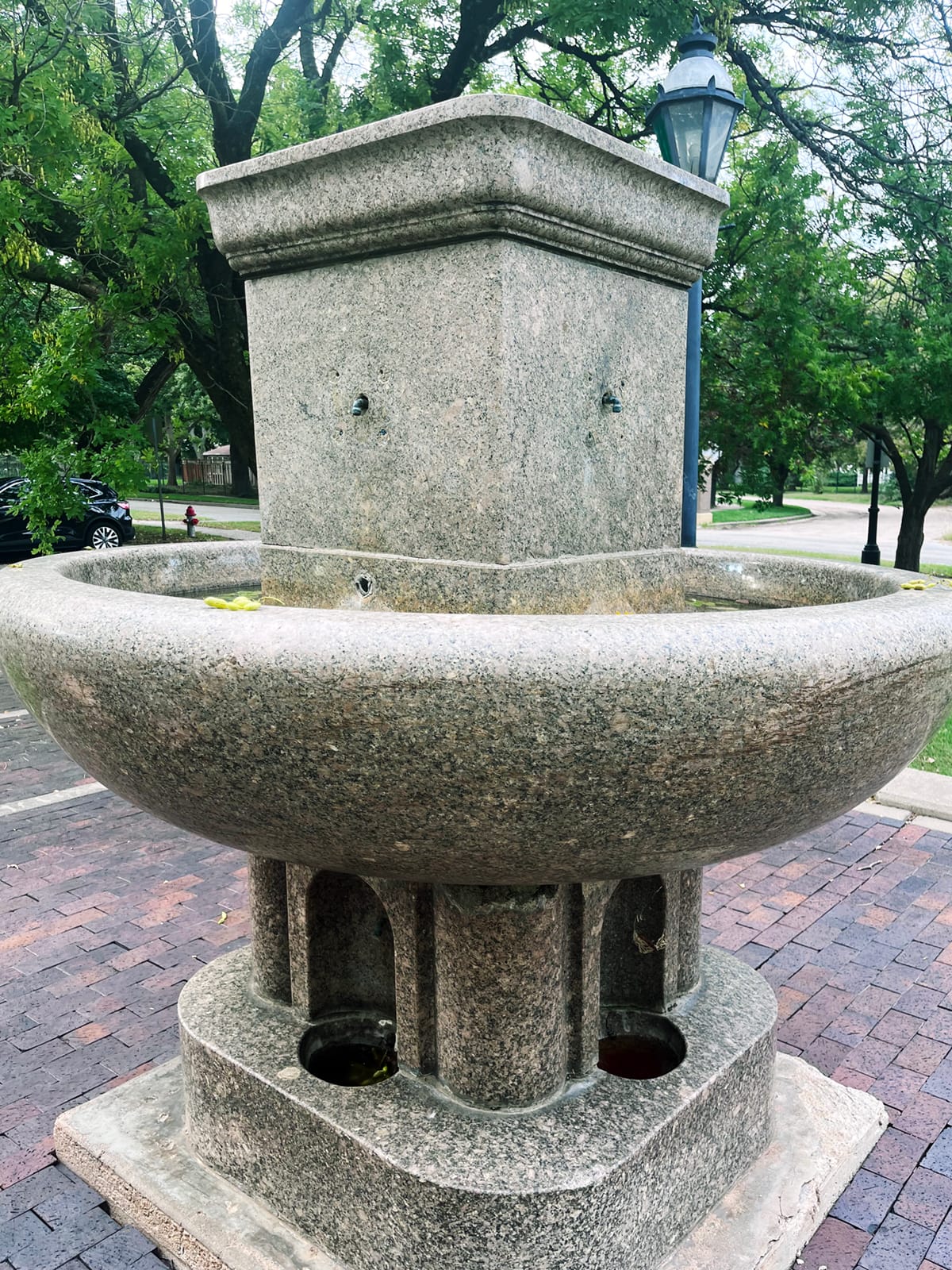
Also gone are three bronze lion heads with spigots, originally on three sides of the fountain’s top pillar at the same height as the plaque. Holes and circular marks are all that remain in these areas. A 1984 Wichita Eagle article by Laura Addison documents the efforts of local attorney Gerald Scott to find the decorative lions when he realized they were missing. After consulting police, Scott determined that the fountain was a victim of vandalism. He speculated it might have been kids acting “for the fun of it” or a collector who “has them hanging in the back yard.”
Of course, no one is leading a horse to water in the fountain these days. Claire Willenberg, a real estate agent with an interest in Wichita’s historic properties, has extensively researched the site. It was “from back when more of our conveyances were horse and buggy, so there was water available for dogs, horses—and people,” Willenberg said. “I would like to get it on the National Register and possibly push to get it functioning again.”
The fountain is attractive and seems made for its home in Victoria Park, which is ironic because this is at least the third place it has been situated. It was always intended to be beautiful as well as functional. In fact, its pleasing appearance was used as a strategy to protect it.

Caring for working horses
The National Humane Alliance fountains were tributes not only to the organization’s founder, Ensign, but to his hero, Henry Bergh, founder of the American Society for the Prevention of Cruelty to Animals. Beginning in 1867, Bergh spearheaded the “fountain movement,” an effort to provide water to working horses. Humane societies across the country began to install water troughs for horses.
In a study of human-animal relations, Arnold Arluke notes that this utilitarian approach made the fountain movement vulnerable to public opinion. Perhaps on legitimate aesthetic grounds, and perhaps as political cover when water shortages became a public issue, municipal art commissioners around the country began denying the designs of some proposed fountains. “To remedy these problems, fountains were reengineered to conserve water and redesigned to capture some of the architectural splendor of their European predecessors,” Arluke writes.
Our free email newsletter is like having a friend who always knows what's happening
Get the scoop on Wichita’s arts & culture scene: events, news, artist opportunities, and more. Free, weekly & worth your while.
No spam. Unsubscribe anytime.
An article from 1910 in the San Jose Mercury News says Herman Lee Ensign was a minister, manager of The Alliance, “a brilliant paper … religious and humane in tone,” and owner of an advertising business that made him a fortune. Inspired by Bergh, he started the National Humane Alliance in New York to continue the fountain movement but died as the work was beginning. The organization used Ensign’s trust to continue distributing watering stations that were also works of art. They enlisted the same company that produced the stone blocks for the Brooklyn Bridge.
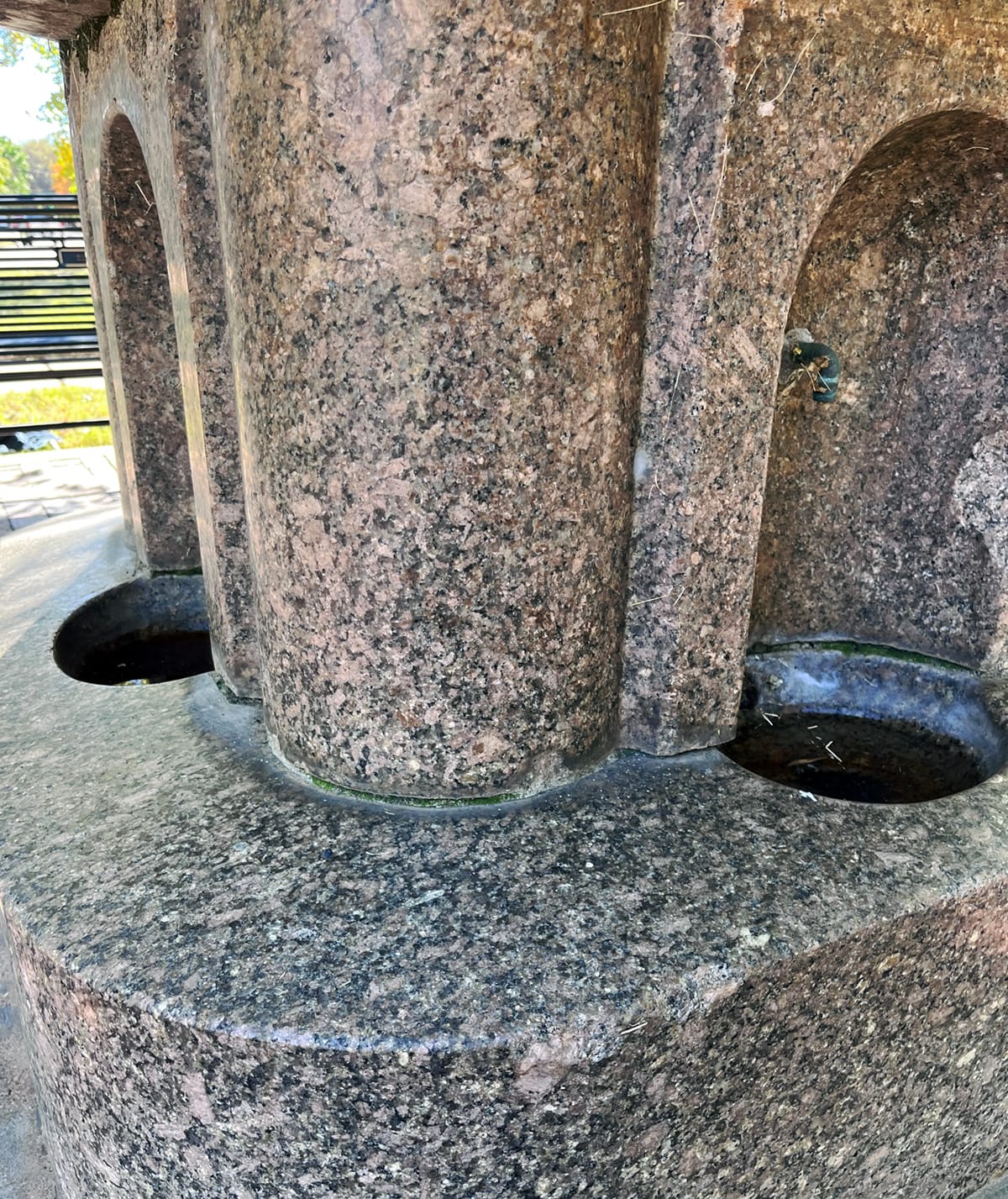
Starting in 1902, the Alliance offered the fountains to cities that would provide suitable locations, installation, and maintenance. In some cases, recipients also paid for shipping from the Maine quarries where the fountains were fashioned. In other cases, as in Wichita, freight costs were part of the grant. About 150 cities in the U.S. and Mexico received fountains before the program wrapped up in 1913. At least 70 still stand, and two have been placed on the National Register of Historic Places.
Most of the fountains matched the design of Wichita’s — 6 feet, 8 inches high with a main bowl 6 feet in diameter, all fashioned from five pieces of granite with a total weight around 10,000 pounds.
The horse fountain’s “neigh-bors”
Wichita’s opportunity to receive a fountain was a case of someone knowing the right person. L.C. Newcomb, who owned the Ponca Tent & Awning Company, perked up his ears when his visiting friend Lewis Mead Seaver, secretary-treasurer of the National Humane Alliance, explained the program. Tipped off by Seaver, Newcomb took the idea to S.F. Stewart, Wichita park commissioner. Compared to newspaper stories about the time and effort other cities invested in getting their fountains, it appears that Wichita’s application process was easy and fast.
When it was received in 1910, the fountain was installed at William and St. Francis Streets. Two years later, all public horse troughs in the city were closed because of an outbreak of glanders, an animal disease that could spread to humans. Horses could still be watered with individual cups, however. In subsequent years, water was shut off completely. Though bitter public outcry stopped an earlier attempt to relocate the fountain, in 1919 it was removed. By 1922, thanks to the efforts of park board chair L.W. Clapp, the fountain was in place at the Riverside Park Zoo. It moved to its current location in the early 1970s.

Victoria Park and the National Humane Alliance Fountain are appreciated by Midtown Wichita residents, and the fountain has been the meeting site for some Historic Midtown tours over the years. A past president of the Midtown Citizens Association told the Eagle that a prankster once dumped soap into it. I heard from some people who grew up trick-or-treating in the neighborhood that the fountain was a landmark that meant they were near what kids called the “Halloween House.”
North End residents also feel connected to the fountain. Michael Martinez said when he was growing up, the water worked. And Silvia Avelar remembered “I used to take my kids there. All my three kids would ride their Hot Wheels there. And I named that cute park ‘Benches’ because of the cute benches they had there. I consider it part of the North End. Love it!”
The Details
National Humane Alliance Fountain
Granite, Bodwell Granite Company, Vinalhaven, Maine
Located in Victoria Park, 17th Street and Park Place, in Wichita's Midtown neighborhood.
The National Humane Alliance Fountain is part of the City of Wichita Public Art Collection
Learn more on the Public Art Archive page for the National Humane Alliance Fountain.
Seth Bate’s book “Winfield’s Walnut Valley Festival” was named a 2023 Kansas Notable Book and won the Tihen Book Award from the Kansas State Historical Foundation. In a previous century, Bate was a National Critics Institute fellow at the Eugene O’Neill Theater Center.
❋ Derby man has the kind of voice that turns heads — and chairs
❋ Socializing while sober: how some Wichitans are cultivating alcohol-free communities
❋ As a small creative business closes, the owner mourns
❋ Painting through it: Autumn Noire on 20 years of making art
❋ How a guy from Wichita resurrected 'Dawn of the Dead'
❋ Bygone Friends University museum housed curious collections
Support Kansas arts writing
The SHOUT is a Wichita-based independent newsroom focused on artists living and working in Kansas. We're partly supported by the generosity of our readers, and every dollar we receive goes directly into the pocket of a contributing writer, editor, or photographer. Click here to support our work with a tax-deductible donation.



